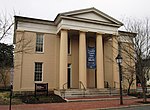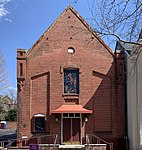Odd Fellows Hall (Alexandria, Virginia)

Odd Fellows Hall is a historic Odd Fellows hall located at Alexandria, Virginia. It is a 2 1/2-story, brick building. It was built in 1864 as a one-story building, and expanded to its present size in 1870. African-American orders like the black Odd Fellows allowed blacks to socialize and put their skills to good use. In 1870, black builder and politician George Seaton was hired to build the Odd Fellows meeting hall in Alexandria, Virginia. For decades the building was used to house the group and many of the social gatherings of the African-American community. In the 1980s the building was converted into condominiums. It is a three-story brick building with decorative detailing and a slate mansard roof. The hall is currently a residential building.
Excerpt from the Wikipedia article Odd Fellows Hall (Alexandria, Virginia) (License: CC BY-SA 3.0, Authors, Images).Odd Fellows Hall (Alexandria, Virginia)
Duke Street, Alexandria
Geographical coordinates (GPS) Address Nearby Places Show on map
Geographical coordinates (GPS)
| Latitude | Longitude |
|---|---|
| N 38.803138888889 ° | E -77.049233333333 ° |
Address
Duke Street 813
22314 Alexandria
Virginia, United States
Open on Google Maps







